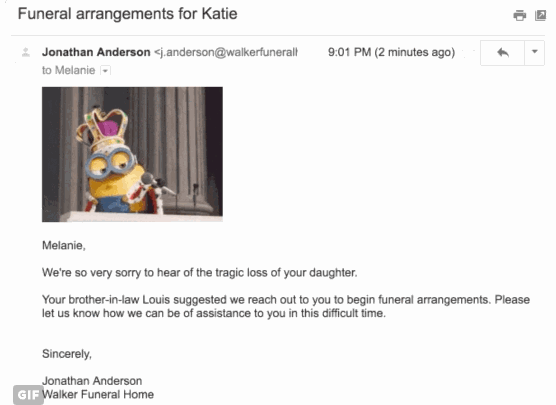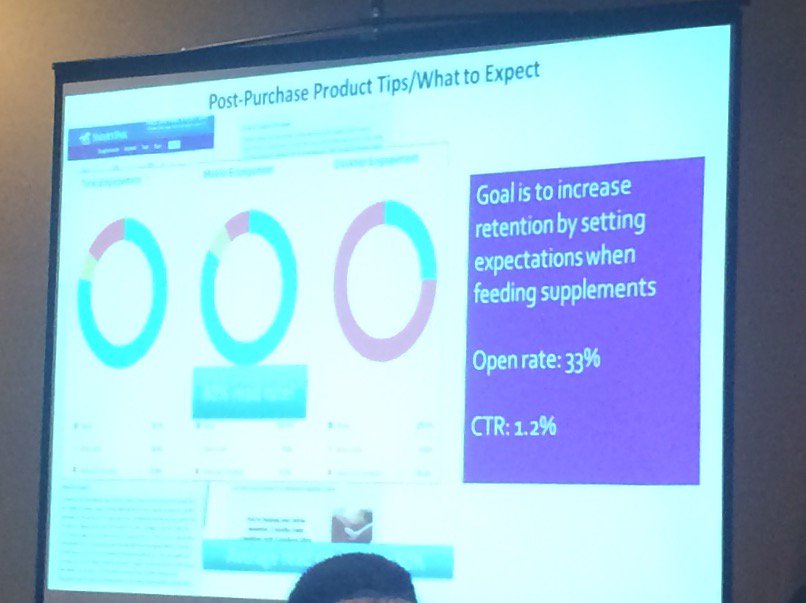Recent Posts
March 2016: The Month In Email
Happy April! I’m just back from the EEC conference in New Orleans, which was terrific. I wrote a quick post about a great session on content marketing, and I’ll have more to add about the rest of the conference over the next week or so. Stay tuned!
Here’s a look at what caught our attention in March:
On the DMARC front, we noted that both Yahoo and mail.ru are moving forward with p=reject, and Steve offered some advice for ESPs and software developers on methods for handling this gracefully. I also answered an Ask Laura question about making the decision to publish DMARC. Look for more on that in this month’s Ask Laura questions…
Our other Ask Laura question this month was about changing ESPs, which senders do for many reasons. It’s useful to know that there will generally be some shifts in deliverability with any move. Different ESPs measure engagement in different ways, and other issues may arise in the transition, so it’s good to be aware of these if you’re contemplating a change.
In industry news, I wrote a sort of meta-post about how the Internet is hard (related: where do you stand on the great Internet vs. internet debate? Comment below!) and we saw several examples of that this month, including a privacy debacle at Florida State University. Marketing is hard, too. I revisited an old post about a fraud case where a woman sued Toyota over an email marketing “prank”. As always, my best practices recommendation for these sorts of things (and everything else!) really boils down to one thing: send wanted email.
Steve wrote extensively about SPF this month in two must-read posts, where he explained the SPF rule of ten and how to optimize your SPF records. He also wrote about Mutt, the much-loved command line email client, and marked the passing of industry pioneer Ray Tomlinson, who, in addition to his many accomplishments, was by all accounts a very thoughtful and generous man.
Finally, I occasionally like to take a moment and follow the twisty paths that lead to my spam folder. Here’s a look at how Ugg spams my email doppelganger, MRS LAURA CORBISHLEY. In other spam news, there’s a lot of very interesting data in the recent 10 Worst list from Spamhaus. Take a look if you haven’t seen it yet.
Don't mess with my email
One thing we tell clients is that people consider their mailbox a very personal space. They’re offended when people invade that personal space without permission, sometimes to an extent that doesn’t seem proportional to the scale of the offense. And we advise senders who have been invited into the inbox to treat it with respect.
Google don’t seem to realize that.
Today, they replaced one of the two “Send Mail” buttons (and the associated key sequence that people have in their finger memory) with one that silently attached a Minions mic-drop gif to the mail, and then hid any future replies to that mail thread. Quite apart from the fact that people use their gmail accounts for professional communications, this is also sabotaging what many people consider their most personal online space. (And, to make it worse, they had a bug such that sometimes the gif would also be added to mail using the other “Send Mail” button).
There’s No Way This Could Go Horribly Wrong.
People were very, very unamused. Google had already pulled the feature by the time I heard about it this morning.
Never take peoples’ mailboxes for granted. Never.
Content is the new volume!
I’m having a great time here at #EEC16. Today is my visit and go to sessions day, since tomorrow I’m speaking at 2 different sessions.
I was lucky enough to get into the Customer Experience session presented by Carey Kegel of SmartPak and Loren McDonald of IBM Marketing Cloud. It was an interesting session.
If you don’t know, SmartPak is a brand focused on selling horse tack and supplements. They initially started off by creating packs of supplements for your horse. This is great for horse owners, as it means the barn staff just needs to add one pack to your horse’s feed. No measuring, no confusion, it’s simple and means your horse gets what they need.
First they started talking about the volume of email sent by SmartPak. Their mails aren’t that consistent, but they mail between 25 and 30 emails a month. Some months last year they mailed every day.
What they started seeing, though, is that the volume of marketing mail drove list churn. The biggest reason users gave for unsubscribing was “too much volume.” The more mail they sent, the more unsubscribes they saw. Even worse, more volume did not translate into revenue. As email volume went up, email performance decreased.
They tested adding content to emails. Just a block on the side of the email with links to content on their website. Adding the content links increased click through rates by 9% and revenue per email by 15%.
These results don’t require the content be in the emails. Using emails to drive recipients to already existing content on the website, including videos and surveys.
The session didn’t specifically discuss deliverability directly, but I think there were some clear deliverability benefits to content marketing. In fact, an email with no call to action, simply a post-purchase “what to expect” email had an open rate of 33%. These types of open rates help improve overall reputation and lead to more inbox deliveries.
The session really drove home how valuable content marketing is. One thing that was continually repeated during the session is that most marketers have the content already. Use email to drive users to the content you already have. Include that content in marketing mails. Meet the recipient’s needs and wants.
There are a couple takeaways I got from the session.
DMARC p=reject
Mail.ru is switching to p=reject.
This means that you should special-case mail.ru wherever …
Actually, no. Time to change that script.
If you operate an ESP or develop mailing list software you should be checking whether the email address that is being used in the From: address of email you’re sending is in a domain that’s publishing p=reject (is a “rejective” email address) automatically. And you should probably do that in real time, whenever you need that piece of information, relying on DNS caching to reduce the network latency.
If you find you’re about to send an email From a rejective email address, you probably shouldn’t send it. Depending on how the recipients’ ISPs handle it, it might be discarded put in the bulk folder or rejected – potentially leading to recipients being unsubscribed.
If you’re writing mailing list software, ideally you should provide your users with several options for handling submissions from rejective email addresses, perhaps some from this list:
Prepping for EEC

Tomorrow I head off to New Orleans to the EEC conference. It’s my first one and I’m really looking forward to meeting some of the people I only know online.
I’ll be speaking on two panels on Friday:
All You Ever Wanted to Know about Deliverability (But Were Afraid to Ask) at 10:50. This is your chance to ask those questions of myself and other experts in the field. I always enjoy Q&A panels and actually hearing from folks what their big deliverability questions are. (and remember, if you have a question, you can always send one to me for Ask Laura)
and the closing Keynote panel
ISP Postmasters & Blacklist Operators: Defending Consumer Inboxes at 1:10. I’m on a panel with various ISP postmasters, blacklist operators and we’ll be talking about what it’s like dealing with the deluge of mail. For instance, there is a huge outbreak of bot-spam at the moment, and a lot of the filters are struggling to keep up. In fact, I’m a last minute replacement for one filter company as they are in all-hands-on-deck firefighting mode to keep their customers safe.
Hope to see you there!
Foundation: A toolkit for designing responsive emails
Zurb announced today version 2 of “Foundation for Email”, a full stack for designing content for responsive email.
It looks rather nice, with features a modern web developer might look for when working on email content. It has many of the things you’d expect a web design stack to have. It support SASS for styling, includes browser sync for previewing content as it’s edited, both on a local browser and on a device, and uses gulp to tie the workflow together.
But it also has some features useful for email that you’d be unlikely to find in a web design stack. It has an inliner, to convert separate SASS/CSS and HTML content into a single HTML document suitable for sending by mail. And it supports a slightly extended HTML format called “Inky”, which lets you use simple tags like <row> and <column> to develop grid-based content, then compile those into old-school HTML tables which mail clients will happily render.
And it comes with ten starter templates for different types of email.
You can find documentation, downloads and examples here.
More Yahoo domains get DMARC'd
Yahoo is turning on p=reject for 62 of their international domains on March 28, 2016. These domains include:
y7mail.com
yahoo.at
yahoo.be
yahoo.bg
yahoo.cl
yahoo.co.hu
yahoo.co.id
yahoo.co.il
yahoo.co.kr
yahoo.co.th
yahoo.co.za
yahoo.com.co
yahoo.com.hr
yahoo.com.my
yahoo.com.pe
yahoo.com.ph
yahoo.com.sg
yahoo.com.tr
yahoo.com.tw
yahoo.com.ua
yahoo.com.ve
yahoo.com.vn
yahoo.cz
yahoo.dk
yahoo.ee
yahoo.fi
yahoo.hr
yahoo.hu
yahoo.ie
yahoo.lt
yahoo.lv
yahoo.nl
yahoo.no
yahoo.pl
yahoo.pt
yahoo.rs
yahoo.se
yahoo.si
yahoo.sk
yahoogroups.co.kr
yahoogroups.com.cn
yahoogroups.com.sg
yahoogroups.com.tw
yahoogrupper.dk
yahoogruppi.it
yahooxtra.co.nz
yahoo.ca
yahoo.co.in
yahoo.co.nz
yahoo.co.uk
yahoo.com.ar
yahoo.com.au
yahoo.com.br
yahoo.com.hk
yahoo.com.mx
yahoo.de
yahoo.es
yahoo.fr
yahoo.gr
yahoo.in
yahoo.it
yahoo.ro
These may cause some delivery issues with international Yahoo domains during the transition period. Anyone using these domains in mail not sent through the Yahoo interface is likely to experience increased bounces at ISPs who are respecting the p=reject request in the DMARC record.
Ugg, a spammer.
I’ve written before about how there is some (I’m sure lovely) woman in the UK who has been connected to my email address. I get a lot of mail for her. Mostly spam. She doesn’t seem to be using the address, but I regularly get mail addressed to MRS. LAURA CORBISHLEY (all caps, always). Typically these messages are advertising various UK stores and products. Sometimes they’re mortgage offers. A few have been sweepstakes only open to UK residents.
I generally forward these spams off to various blocklists with the note it’s my “UK spamtrap” and they take whatever actions seem appropriate to them. Today, though, I got my first US spam to Mrs. Laura Corbishly. From a Yesmail customer called sanuk.com. I’m getting a website error (they get smacked for spamming already?) but a little research tells me this is shoe company that owns a bunch of brands, including Ugg.
Today, though, I got my first US spam to Mrs. Laura Corbishly. From a Yesmail customer called sanuk.com. I’m getting a website error (they get smacked for spamming already?) but a little research tells me this is shoe company that owns a bunch of brands, including Ugg.
Yes, Ugg a Spammer. They even even have a disclaimer at the bottom of the email telling me they’re a spammer!
Not so much, no. It appears, though, that the data brokers selling Mrs. Corbishley’s name connected to my email address have figured out that no one ever actually acts on any of their UK offers. So now they’re selling into the US market in hopes that they might entice a purchase?
On a purely nosy level, I’d love to know who was selling the address. First off, I’d love to know where they got this info in the first place. Secondly, what horrible database are they using that keeps name data in all caps? (When I get email to this trap I think they’re shouting at me, as if I’m the one who is wrong about my name. Maybe they think if they yell at me loud enough will I decide I really am the happy wife of Mr. Corbishley of Swindon, UK. )
I do tell clients that it’s useful to remind customers that they signed up for mail, especially if they haven’t mailed for a while. So I know not every email with a “you opted in” reminder is spam, but I only notice those things when I haven’t opted in. It’s something I mostly gloss over if I really did opt-in. I wonder if this is how other folks react to “you opted in” notices, too.
I do recommend the reminder be much more specific than “you opted in at our website.” Give the user a date, a time, something that isn’t just something any company can, and many do, make up.
HE.net DNS problems
Hurricane Electric had a significant outage of their authoritative DNS servers this morning, causing them to return valid responses with no results for all(?) queries. This will have caused delivery problems for any mail going to domains using HE.net DNS – which will include some of their colocation customers, as well as users of their free services – but also will have caused reverse DNS to fail for most servers hosted by Hurricane Electric worldwide, so if any of your mail is being sent from HE hosted machines you may have seen problems.
(We’re HE customers so we noticed. Still happy with them as a vendor.)
Categories
Tags
- 2010
- 2016
- 2fa
- 419
- 4xx
- 554
- 5xx
- @
- Aarp
- Abacus
- Abandoned
- Aboutmyemail
- Abuse
- Abuse Desk
- Abuse Enforcement
- Abuse Prevention
- Academia
- Accreditation
- Acme
- Acquisition
- Address Book
- Addresses
- Administrivia
- Adsp
- Advanced Delivery
- Advertiser
- Advertising
- Advice
- Affiliate
- Affiliates
- After the Email
- Alerts
- Algorithm
- Alice
- Alignment
- Allcaps
- Alt Text
- AMA
- Amazon
- Amp
- Amsterdam
- Analysis
- Anecdotes
- Anti-Spam
- Anti-Spam Laws
- Anti-Spammers
- Antwort
- AOL
- Appeals
- Appearances
- Appending
- Apple
- Arc
- Arf
- Arrest
- Arrests
- Ascii
- Asides
- Ask Laura
- Askwttw
- Assertion
- Assumptions
- ATT
- Attacks
- Attention
- Attrition
- Audit
- Authentication
- Authentication. BT
- Autonomous
- Award
- B2B
- B2C
- Backhoe
- Backscatter
- Banks
- Barracuda
- Barry
- Base64
- Base85
- Bcp
- Bear
- Bears
- Behaviour
- Benchmark
- BESS
- Best Practices
- Bgp
- Bimi
- Bit Rot
- Bitly
- Bizanga
- Black Friday
- Blackfriday
- Blacklist
- Blacklists
- Blast
- Blo
- Block
- Blockin
- Blocking
- Blocklist
- Blocklisting
- Blocklists
- Blocks
- Blog
- Blog Links
- Blogroll
- Blogs
- Bob
- Boca
- Bofa
- Book Review
- Bot
- Botnet
- Botnets
- Bots
- Bounce
- Bounce Handling
- Bounces
- Branding
- Brands
- Breach
- Breaches
- Breech
- Bronto
- Browser
- Bsi
- Bucket
- Bulk
- Bulk Folder
- Bulk Mail
- Business
- Business Filters
- Buying Leads
- Buying Lists
- C-28
- CA
- Caa
- Cache
- Cadence
- CAH
- California
- Campaign
- CAN SPAM
- Canada
- Candy
- Candycandycandy
- Canonicalization
- Canspam
- Captcha
- Career Developmnent
- Careers at WttW
- Cargo Cult
- Case Law
- Cases
- CASL
- Cat
- Cbl
- CDA
- Cert
- Certification
- CFL
- Change
- Charter
- Cheat
- Cheese
- Choicepoint
- Choochoo
- Christmas
- Chrome
- Cidr
- Cisco
- Civil
- Clear.net
- Clearwire.net
- Cli
- Click
- Click Through
- Click Tracking
- Clicks
- Clickthrough
- Client
- Cloudflare
- Cloudmark
- Cname
- Co-Reg
- Co-Registration
- Cocktail
- Code
- COI
- Comcast
- Comments
- Commercial
- Communication
- Community
- Comodo
- Comparison
- Competitor
- Complaint
- Complaint Rates
- Complaints
- Compliancce
- Compliance
- Compromise
- Conference
- Conferences
- Confirmation
- Confirmed (Double) Opt-In
- Confirmed Opt-In
- Congress
- Consent
- Conservatives
- Consistency
- Constant Contact
- Consultants
- Consulting
- Content
- Content Filters
- Contracts
- Cookie
- Cookie Monster
- COPL
- Corporate
- Cost
- Court Ruling
- Cox
- Cox.net
- Cpanel
- Crib
- Crime
- CRM
- Crowdsource
- Crtc
- Cryptography
- CS&M
- CSRIC
- CSS
- Curl
- Customer
- Cyber Monday
- Czar
- Data
- Data Hygiene
- Data Security
- Data Segmentation
- Data Verification
- DBL
- Dbp
- Ddos
- Dea
- Dead Addresses
- Dedicated
- Dedicated IPs
- Defamation
- Deferral
- Definitions
- Delays
- Delisting
- Deliverability
- Deliverability Experts
- Deliverability Improvement
- Deliverability Summit
- Deliverability Week
- Deliverability Week 2024
- Deliverabiltiy
- DeliverabiltyWeek
- Delivery Blog Carnival
- Delivery Discussion
- Delivery Emergency
- Delivery Experts
- Delivery Improvement
- Delivery Lore
- Delivery News
- Delivery Problems
- Dell
- Design
- Desks
- Dhs
- Diagnosis
- Diff
- Dig
- Direct Mag
- Direct Mail
- Directives
- Discounts
- Discovery
- Discussion Question
- Disposable
- Dk
- DKIM
- Dkimcore
- DMA
- Dmarc
- Dns
- Dnsbl
- Dnssec
- Docs
- Doingitright
- Domain
- Domain Keys
- Domain Reputation
- DomainKeys
- Domains
- Domains by Proxy
- Dontpanic
- Dot Stuffing
- Dotcom
- Double Opt-In
- Dublin
- Dyn
- Dynamic Email
- E360
- Earthlink
- Ec2
- Ecoa
- Economics
- ECPA
- Edatasource
- Edns0
- Eec
- Efail
- Efax
- Eff
- Election
- Email Address
- Email Addresses
- Email Change of Address
- Email Client
- Email Design
- Email Formats
- Email Marketing
- Email Verification
- Emailappenders
- Emailgeeks
- Emails
- Emailstuff
- Emoji
- Emoticon
- Encert
- Encryption
- End User
- Endusers
- Enforcement
- Engagement
- Enhanced Status Code
- Ennui
- Entrust
- Eol
- EOP
- Epsilon
- Esp
- ESPC
- ESPs
- EU
- Ev Ssl
- Evaluating
- Events
- EWL
- Exchange
- Excite
- Expectations
- Experience
- Expires
- Expiring
- False Positives
- FAQ
- Fathers Day
- Fbl
- FBL Microsoft
- FBLs
- Fbox
- FCC
- Fcrdns
- Featured
- Fedex
- Feds
- Feedback
- Feedback Loop
- Feedback Loops
- Fiction
- Filter
- Filter Evasion
- Filtering
- Filterings
- Filters
- Fingerprinting
- Firefox3
- First Amendment
- FISA
- Flag Day
- Forensics
- Format
- Formatting
- Forms
- Forwarding
- Fraud
- Freddy
- Frequency
- Friday
- Friday Spam
- Friendly From
- From
- From Address
- FTC
- Fussp
- Gabbard
- Gdpr
- Geoip
- Gevalia
- Gfi
- Git
- Giveaway
- Giving Up
- Global Delivery
- Glossary
- Glyph
- Gmail
- Gmails
- Go
- Godaddy
- Godzilla
- Good Email Practices
- Good Emails in the Wild
- Goodmail
- Google Buzz
- Google Postmaster Tools
- Graphic
- GreenArrow
- Greylisting
- Greymail
- Groupon
- GT&U
- Guarantee
- Guest Post
- Guide
- Habeas
- Hack
- Hacking
- Hacks
- Hall of Shame
- Harassment
- Hard Bounce
- Harvesting
- Harvey
- Hash
- Hashbusters
- Headers
- Heartbleed
- Hearts
- HELO
- Help
- Henet
- Highspeedinternet
- Hijack
- History
- Holiday
- Holidays
- Holomaxx
- Hostdns4u
- Hostile
- Hostname
- Hotmail
- How To
- Howto
- Hrc
- Hsts
- HTML
- HTML Email
- Http
- Huey
- Humanity
- Humor
- Humour
- Hygiene
- Hypertouch
- I18n
- ICANN
- Icloud
- IContact
- Identity
- Idiots
- Idn
- Ietf
- Image Blocking
- Images
- Imap
- Inbox
- Inbox Delivery
- Inboxing
- Index
- India
- Indiegogo
- Industry
- Infection
- Infographic
- Information
- Inky
- Inline
- Innovation
- Insight2015
- Integration
- Internationalization
- Internet
- Intuit
- IP
- IP Address
- Ip Addresses
- IP Repuation
- IP Reputation
- IPhone
- IPO
- Ipv4
- Ipv6
- Ironport
- Ironport Cisco
- ISIPP
- ISP
- ISPs
- J.D. Falk Award
- Jail
- Jaynes
- JD
- Jobs
- Json
- Junk
- Juno/Netzero/UOL
- Key Rotation
- Keybase
- Keynote
- Kickstarter
- Kraft
- Laposte
- Lavabit
- Law
- Laws
- Lawsuit
- Lawsuits
- Lawyer
- Layout
- Lead Gen
- Leak
- Leaking
- Leaks
- Legal
- Legality
- Legitimate Email Marketer
- Letsencrypt
- Letstalk
- Linked In
- Links
- List Hygiene
- List Management
- List Purchases
- List the World
- List Usage
- List-Unsubscribe
- Listing
- Listmus
- Lists
- Litmus
- Live
- Livingsocial
- London
- Lookup
- Lorem Ipsum
- Lycos
- Lyris
- M3AAWG
- Maawg
- MAAWG2007
- Maawg2008
- MAAWG2012
- MAAWGSF
- Machine Learning
- Magill
- Magilla
- Mail Chimp
- Mail Client
- MAIL FROM
- Mail Privacy Protection
- Mail Problems
- Mail.app
- Mail.ru
- Mailboxes
- Mailchimp
- Mailgun
- Mailing Lists
- Mailman
- Mailop
- Mainsleaze
- Maitai
- Malicious
- Malicious Mail
- Malware
- Mandrill
- Maps
- Marketer
- Marketers
- Marketing
- Marketo
- Markters
- Maths
- Mcafee
- Mccain
- Me@privacy.net
- Measurements
- Media
- Meh
- Meltdown
- Meme
- Mentor
- Merry
- Messagelabs
- MessageSystems
- Meta
- Metric
- Metrics
- Micdrop
- Microsoft
- Milter
- Mime
- Minimal
- Minshare
- Minute
- Mit
- Mitm
- Mobile
- Models
- Monitoring
- Monkey
- Monthly Review
- Mpp
- MSN/Hotmail
- MSN/Hotmail
- MTA
- Mua
- Mutt
- Mx
- Myths
- Myvzw
- Netcat
- Netsol
- Netsuite
- Network
- Networking
- New Year
- News
- News Articles
- Nhi
- NJABL
- Now Hiring
- NTP
- Nxdomain
- Oath
- Obituary
- Office 365
- Office365
- One-Click
- Only Influencers
- Oops
- Opaque Cookie
- Open
- Open Detection
- Open Rate
- Open Rates
- Open Relay
- Open Tracking
- Opendkim
- Opens
- Openssl
- Opt-In
- Opt-Out
- Optonline
- Oracle
- Outage
- Outages
- Outblaze
- Outlook
- Outlook.com
- Outrage
- Outreach
- Outsource
- Ownership
- Owning the Channel
- P=reject
- Pacer
- Pander
- Panel
- Password
- Patent
- Paypal
- PBL
- Penkava
- Permission
- Personalities
- Personalization
- Personalized
- Pgp
- Phi
- Philosophy
- Phish
- Phishers
- Phishing
- Phising
- Photos
- Pii
- PIPA
- PivotalVeracity
- Pix
- Pluscachange
- Podcast
- Policies
- Policy
- Political Mail
- Political Spam
- Politics
- Porn
- Port25 Blocking
- Postfix
- Postmaster
- Power MTA
- Practices
- Predictions
- Preferences
- Prefetch
- Preview
- Primers
- Privacy
- Privacy Policy
- Privacy Protection
- Private Relay
- Productive Mail
- Promotions
- Promotions Tab
- Proofpoint
- Prospect
- Prospecting
- Protocols
- Proxy
- Psa
- PTR
- Public Suffix List
- Purchased
- Purchased Lists
- Purchases
- Purchasing Lists
- Questions
- Quoted Printable
- Rakuten
- Ralsky
- Rant
- Rate Limiting
- Ray Tomlinson
- Rc4
- RDNS
- Read
- Ready to Post
- Readytopost
- Real People
- Realtime Address Verification
- Recaptcha
- Received
- Receivers
- Recipient
- Recipients
- Redirect
- Redsnapper
- Reference
- Registrar
- Registration
- Rejection
- Rejections
- Rejective
- Relationship
- Relevance
- Relevancy
- Removals
- Render Rate
- Rendering
- Repost
- Repudiation
- Reputation
- Requirements
- Research
- Resources
- Responsive
- Responsive Design
- Responsys
- Retail
- Retired Domains
- Retro
- Return Path
- Return Path Certified
- ReturnPath
- Reunion.com
- Reverse Dns
- Rfc
- RFC2047
- RFC2821/2822
- RFC5321/5322
- RFC5322
- RFC8058
- RFC821/822
- RFCs
- Roadr
- RoadRunner
- Rodney Joffe
- ROKSO
- Role Accounts
- Rollout
- RPost
- RPZ
- Rule 34
- Rules
- Rum
- Rustock
- S.1618
- SaaS
- Sales
- Salesforce
- Sass
- SBCGlobal
- Sbl
- Scam
- Scammers
- Scams
- Scanning
- Scraping
- Screamer
- Screening
- Script
- Sec
- Secure
- Security
- Segmentation
- Selligent
- Send
- Sender
- Sender Score
- Sender Score Certified
- Senderbase
- Senderid
- Senders
- Senderscore
- Sendgrid
- Sending
- Sendy
- Seo
- Service
- Services
- Ses
- Seth Godin
- SFDC
- SFMAAWG2009
- SFMAAWG2010
- SFMAAWG2014
- Shared
- Shell
- Shouting
- Shovel
- Signing
- Signups
- Silly
- Single Opt-In
- Slack
- Slicing
- Smarthost
- Smiley
- Smime
- SMS
- SMTP
- Snds
- Snowshoe
- Soa
- Socia
- Social Media
- Social Networking
- Soft Bounce
- Software
- Sony
- SOPA
- Sorbs
- Spam
- Spam Blocking
- Spam Definition
- Spam Filtering
- Spam Filters
- Spam Folder
- Spam Law
- Spam Laws
- Spam Reports
- Spam Traps
- Spam. IMessage
- Spamarrest
- Spamassassin
- Spamblocking
- Spamcannibal
- Spamcon
- Spamcop
- Spamfiltering
- Spamfilters
- Spamfolder
- Spamhaus
- Spamhause
- Spammer
- Spammers
- Spammest
- Spamming
- Spamneverstops
- Spamresource
- Spamtrap
- Spamtraps
- Spamza
- Sparkpost
- Speaking
- Special Offers
- Spectre
- Spf
- Spoofing
- SproutDNS
- Ssl
- Standards
- Stanford
- Starttls
- Startup
- State Spam Laws
- Statistics
- Storm
- Strategy
- Stunt
- Subject
- Subject Lines
- Subscribe
- Subscriber
- Subscribers
- Subscription
- Subscription Process
- Success Stories
- Suing
- Suppression
- Surbl
- Sureclick
- Suretymail
- Survey
- Swaks
- Syle
- Symantec
- Tabbed Inbox
- Tabs
- Tagged
- Tagging
- Target
- Targeting
- Techincal
- Technical
- Telnet
- Template
- Tempo
- Temporary
- Temporary Failures
- Terminology
- Testing
- Text
- Thanks
- This Is Spam
- Throttling
- Time
- Timely
- TINS
- TLD
- Tlp
- TLS
- TMIE
- Tmobile
- Too Much Mail
- Tool
- Tools
- Toomuchemail
- Tor
- Trademark
- Traffic Light Protocol
- Tragedy of the Commons
- Transactional
- Transition
- Transparency
- Traps
- Travel
- Trend/MAPS
- Trend Micro
- Trend/MAPS
- Trigger
- Triggered
- Troubleshooting
- Trustedsource
- TWSD
- Txt
- Types of Email
- Typo
- Uce
- UCEprotect
- Unblocking
- Uncategorized
- Unexpected Email
- Unicode
- Unroll.me
- Unsolicited
- Unsubcribe
- Unsubscribe
- Unsubscribed
- Unsubscribes
- Unsubscribing
- Unsubscription
- Unwanted
- URIBL
- Url
- Url Shorteners
- Usenet
- User Education
- Utf8
- Valentine's Day
- Validation
- Validity
- Value
- Valueclick
- Verification
- Verizon
- Verizon Media
- VERP
- Verticalresponse
- Vetting
- Via
- Video
- Violence
- Virginia
- Virtumundo
- Virus
- Viruses
- Vmc
- Vocabulary
- Vodafone
- Volume
- Vzbv
- Wanted Mail
- Warmup
- Weasel
- Webinar
- Webmail
- Weekend Effect
- Welcome Emails
- White Space
- Whitelisting
- Whois
- Wiki
- Wildcard
- Wireless
- Wiretapping
- Wisewednesday
- Women of Email
- Woof
- Woot
- Wow
- Wtf
- Wttw in the Wild
- Xbl
- Xfinity
- Xkcd
- Yahoo
- Yahoogle
- Yogurt
- Zoidberg
- Zombie
- Zombies
- Zoominfo
- Zurb
